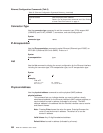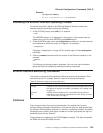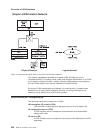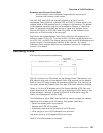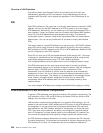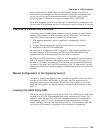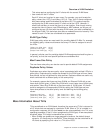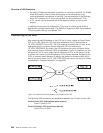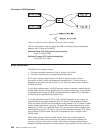
explicit assignment; by default, 200 of the 256 possible selectors per ESI are
reserved for explicit assignment. Run-time selector assignment is beneficial when
you do not need to control the assigned selector, for example, when you are
configuring clients in Classical IP that are not paired with an ARP server.
While ATM addresses must be unique among LE components, LE components can
use the same ATM addresses as non-LE components, such as Classical IP servers.
Overview of Related ILMI Functions
ILMI defines a set of SNMP-based procedures used to manage the user-network
interface (UNI) between an ATM end system and an ATM switch. The following
three ILMI functions are particularly relevant to LAN emulation:
1. ATM address registration, which is described in “Addressing in ATM” on
page 257
2. Dynamic determination of the signaling version being run at the switch
3. Acquisition of the LECS ATM addresses
As mentioned in “Addressing in ATM” on page 257, ATM address registration is a
joint effort between ATM end systems and switches. ATM addresses must be
registered with the switch before calls can be placed or received.
By default, the ATM interfaces of a router use ILMI procedures to query the switch
MIB in an attempt to determine the signaling version (UNI 3.0 or 3.1) being run at
the switch. If the query succeeds, the ATM interface runs the same UNI version as
the switch; if the query fails, the ATM interface runs UNI 3.0. Alternatively, you can
override the default and explicitly configure the UNI version that will run on the ATM
interface.
Manual Configuration of the Signaling Version
You need to configure the signaling version manually if the ATM switch runs UNI 3.1
and has no UNI Version MIB variable. In this case, the ATM interface cannot
dynamically determine the UNI version. Because the ATM interface in the router
uses UNI 3.0 by default, you should manually configure the ATM interface to use
UNI 3.1.
Locating the LECS Using ILMI
ILMI is the method of choice for locating the LECS. The ILMI MIB at the ATM switch
includes a list of LECS ATM addresses that can be retrieved by LE clients. This
method is useful because the LECS ATM addresses need only be configured at
ATM switches, not at LE clients, and there are fewer switches than LE clients.
Clients attempt to connect to the first LECS on this list. If the connection fails, they
try the next LECS address in succession until a connection is established.
Overview of LAN Emulation
Chapter 20. Overview of LAN Emulation 259




